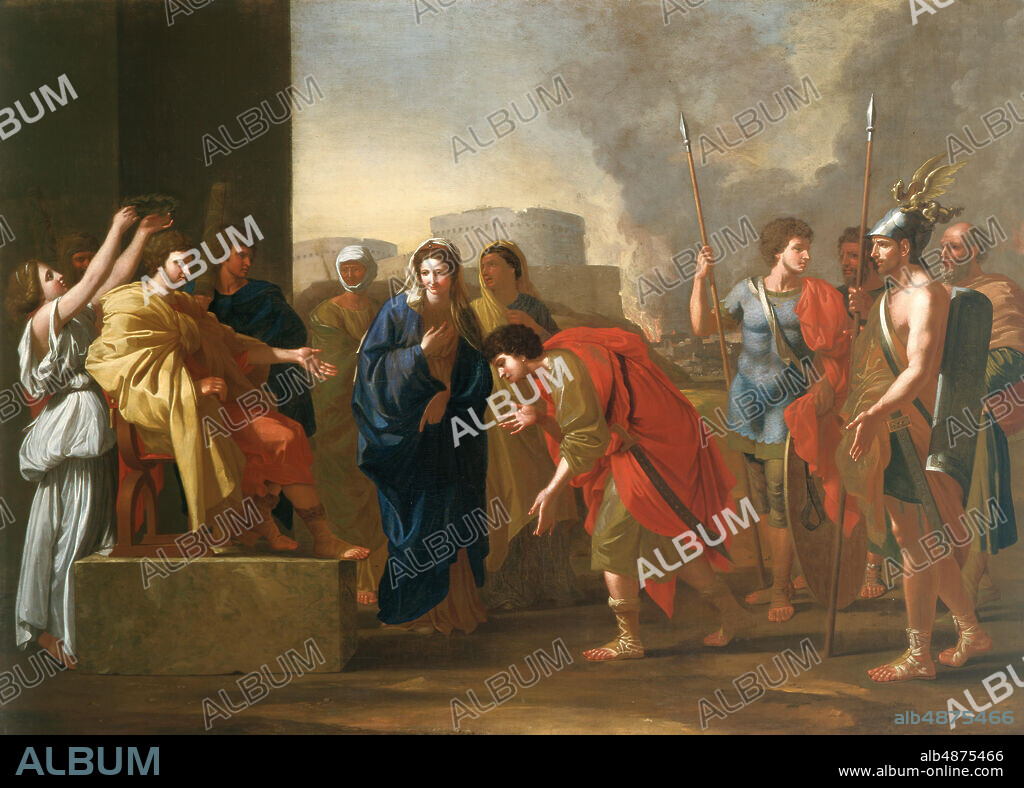alb4875466
John Smibert, The Continence of Scipio, ca. 1719-1722, oil on canvas, 45 3/4 in. x 62 5/8 in. (116.21 cm x 159.07 cm), Smibert's painting is a copy of a 1640 painting by the revered French painter Nicolas Poussin. Its subject derives from Roman history. During the Second Punic War, the Roman general Publius Cornelius Scipio Africanus decided to return his war spoils, including the bride of his enemy Allucius, the young prince of the Celtiberians. Scipio's moral fortitude presented an ideal subtext for Poussin's classical interpretation. John Smibert, the copyist, was a portrait painter from Scotland who trained in London and later set out with Dean George Berkeley to found a college in Bermuda. This painting was intended to be part of the college's teaching collection, but when that project fell through, Smibert exhibited it in his Boston studio and art supply store. In Boston it set an example for John Singleton Copley, who admired it. At Bowdoin College since James Bowdoin III's bequest in 1813, the work has contributed to the education of countless generations of students.

|
Add to another lightbox |
|
Add to another lightbox |



Caption:
John Smibert, The Continence of Scipio, ca. 1719-1722, oil on canvas, 45 3/4 in. x 62 5/8 in. (116.21 cm x 159.07 cm), Smibert's painting is a copy of a 1640 painting by the revered French painter Nicolas Poussin. Its subject derives from Roman history. During the Second Punic War, the Roman general Publius Cornelius Scipio Africanus decided to return his war spoils, including the bride of his enemy Allucius, the young prince of the Celtiberians. Scipio's moral fortitude presented an ideal subtext for Poussin's classical interpretation. John Smibert, the copyist, was a portrait painter from Scotland who trained in London and later set out with Dean George Berkeley to found a college in Bermuda. This painting was intended to be part of the college's teaching collection, but when that project fell through, Smibert exhibited it in his Boston studio and art supply store. In Boston it set an example for John Singleton Copley, who admired it. At Bowdoin College since James Bowdoin III's bequest in 1813, the work has contributed to the education of countless generations of students.
Credit:
Album / quintlox
Releases:
Model: No - Property: No
Rights questions?
Rights questions?
Image size:
7128 x 5116 px | 104.3 MB
Print size:
60.4 x 43.3 cm | 23.8 x 17.1 in (300 dpi)
Keywords:
116.21 CM X 159.07 CM • 1640 PAINTING • 1813 • 45 3/4. X 62 5/8 • ADMIRED. • ART SUPPLY STORE. • BERMUDA. • BOSTON STUDIO • BOSTON • BOWDOIN COLLEGE • BRIDE • CA. 1719-1722 • CANVAS • CELTIBERIANS. SCIPIO'S MORAL FORTITUDE PRESENTED • CITY OF LONDON • CLASS • COLLEGE'S TEACHING COLLECTION • COLLÈGE • CONTINENCE • CONTRIBUTED • COPY • COPYIST • COUNTLESS GENERATIONS • COURSE • DEAN GEORGE BERKELEY • EDUCATING • EDUCATION • ENEMY ALLUCIUS • EXAMPLE • GO BACK • IDEAL SUBTEXT • INSTRUCTING • INSTRUCTION • INTENDED • JAMES BOWDOIN III'S BEQUEST • JOHN SINGLETON COPLEY • JOHN SMIBERT • LATER SET OUT • LESSON (SCHOOL) • LESSON • LONDON • LONDON. • OIL • PAINT • PAINTING • PART • PEDAGOGY • PERIOD • PORTRAIT PAINTER • POUSSIN'S CLASSICAL INTERPRETATION. JOHN SMIBERT • PROJECT FELL • RETURN • REVERED FRENCH PAINTER NICOLAS POUSSIN. • ROMAN GENERAL PUBLIUS CORNELIUS SCIPIO AFRICANUS DECIDED • ROMAN HISTORY. • SCIPIO • SCOTLAND UNITED KINGDOM • SCOTLAND • SECOND PUNIC WAR • SET • SMIBERT EXHIBITED • SMIBERT'S PAINTING • STUDENT • STUDENTS • SUBJECT DERIVES • TEACHING • TEACHING, EDUCATION • TRAINED • TRAINING • WAR SPOILS • WORK • YOUNG PRINCE
 Pinterest
Pinterest Twitter
Twitter Facebook
Facebook Copy link
Copy link Email
Email

